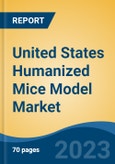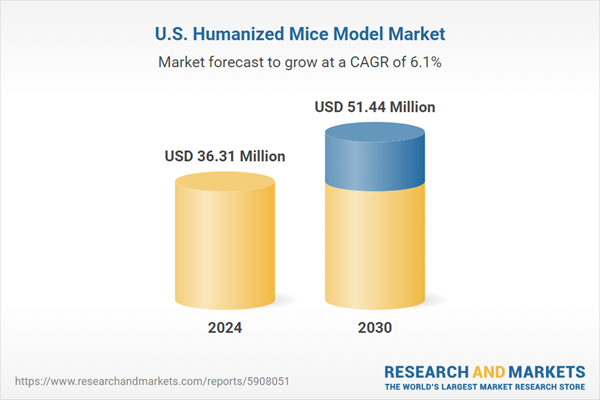Speak directly to the analyst to clarify any post sales queries you may have.
10% Free customizationThis report comes with 10% free customization, enabling you to add data that meets your specific business needs.
Their relevance spans across multiple domains, including oncology, immunology, infectious disease research, and drug development. As part of the broader shift toward human-based testing methods, initiatives by institutions like the NIH and FDA are advancing alternatives such as organ-on-chip technologies while reinforcing the importance of accurate in vivo models like humanized mice. These developments are enhancing research precision and expanding capabilities in disease modeling and therapeutic evaluation.
Key Market Drivers
Increasing Need for Personalized Medicine
The rising focus on personalized medicine is significantly driving the demand for humanized mice models in the United States. These models offer a close approximation of human physiological and genetic variability, which is critical for developing customized therapies. Their human-like immune systems make them especially suitable for evaluating targeted treatments in oncology, immunology, and chronic disease management.With a growing aging population - over 94% of individuals aged 60 and above having at least one chronic illness and nearly 78% managing multiple conditions - personalized approaches to treatment are becoming essential. Humanized mice enable researchers to test patient-specific responses to therapies, accelerating the development of precision medicine. As the U.S. continues to lead in biomedical innovation, the demand for reliable, predictive in vivo models is expected to grow in parallel with advancements in tailored healthcare solutions.
Key Market Challenges
High Costs Associated with Development of Humanized Mice Models
The considerable costs linked to the development and maintenance of humanized mice models present a significant hurdle in the U.S. market. Creating these models involves complex genetic engineering, skilled personnel, and specialized facilities for housing and care. These requirements drive up costs and can limit access for smaller research institutions or startups. Moreover, funding constraints and budget limitations often make it challenging for researchers to consistently utilize these models, despite their scientific value. As a result, some institutions may turn to alternative models that are more affordable but potentially less representative of human biology. The high cost factor could slow down broader adoption, making it essential for stakeholders to seek funding support or cost-reduction innovations to sustain growth and accessibility in the market.Key Market Trends
Increased Use in Oncology Research
The utilization of humanized mice models in oncology research is rising significantly across the United States. These models provide an advanced platform for studying the behavior of human tumor cells and evaluating therapeutic responses in a physiologically relevant context. Their use is becoming increasingly prevalent as cancer rates grow and demand intensifies for more accurate preclinical models.Advancements in genetic engineering have enhanced model precision, making them more effective in mimicking human cancer biology. With expanding government and private funding for oncology research, as well as the development of models tailored to specific cancer types, humanized mice are playing a central role in enabling deeper insights into cancer pathogenesis and treatment efficacy. This trend is expected to further accelerate market growth as the need for translational research tools continues to expand.
Key Market Players
- Charles River Laboratories International, Inc.
- The Jackson Laboratory
- Taconic Biosciences Inc.
- Hera BioLabs
- Ingenious Targeting Laboratory Inc.
- Champions Oncology, Inc.
- Yecuris Corporation
- Crown Bioscience Inc.
- Taconic Biosciences Inc.
- HuMurine Technologies
Report Scope:
In this report, the United States Humanized Mice Model Market has been segmented into the following categories, in addition to the industry trends which have also been detailed below:United States Humanized Mice Model Market, By Type:
- Genetic Humanized Mice Model
- Cell-based Humanized Mice Model
United States Humanized Mice Model Market, By Application:
- Oncology Studies
- Immunology and Inflammation Studies
- Others
United States Humanized Mice Model Market, By End User:
- Pharmaceutical & Biotechnology Companies
- Academic & Research Institutes
- Contract Research Organizations
United States Humanized Mice Model Market, By Region:
- Northeast Region
- Midwest Region
- West Region
- South Region
Competitive Landscape
Company Profiles: Detailed analysis of the major companies present in the United States Humanized Mice Model Market.Available Customizations
With the given market data, the publisher offers customizations according to a company's specific needs. The following customization options are available for the report.Company Information
- Detailed analysis and profiling of additional market players (up to five).
This product will be delivered within 1-3 business days.
Table of Contents
Companies Mentioned
- Charles River Laboratories International, Inc.
- The Jackson Laboratory
- Taconic Biosciences Inc.
- Hera BioLabs
- Ingenious Targeting Laboratory Inc.
- Champions Oncology, Inc.
- Yecuris Corporation
- Crown Bioscience Inc.
- Taconic Biosciences Inc.
- HuMurine Technologies
Table Information
| Report Attribute | Details |
|---|---|
| No. of Pages | 85 |
| Published | July 2025 |
| Forecast Period | 2024 - 2030 |
| Estimated Market Value ( USD | $ 36.31 Million |
| Forecasted Market Value ( USD | $ 51.44 Million |
| Compound Annual Growth Rate | 6.1% |
| Regions Covered | United States |
| No. of Companies Mentioned | 10 |









